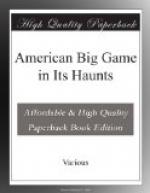[Illustration: PROBABLY LARGEST KNOWN ALASKA MOOSE HEAD—KENAI PENINSULA, 1899 EXTREME SPREAD, 78-1/2 INCHES—WEIGHT OF SKULL AND ANTLERS, 93 LBS]
Several heads from the Kenai Peninsula ranging over six feet are authentic; a photograph of the largest moose head in the world is published herewith. This head is in the possession of the Field Columbian Museum at Chicago, and measures 78-1/2 inches spread. The animal that bore it stood about seven feet at shoulders, but this height is not infrequently equaled by eastern moose. The weight of the dried skull and antlers was ninety-three pounds, the palmation being in places 2-1/8 inches thick.
There are several large heads in the possession of American taxidermists, which, if properly authenticated, would prove of interest. No head, however, is of much value as a record unless its history is well known, and unless it has been in the hands of responsible persons. The measurements of antler spread can be considered authentic only when the skull is intact. If the skull is split an almost imperceptible paring of the skull bones at the joint would suffice to drop the antlers either laterally out of their proper plane, or else pitch the main beam backward. By either of these devices a couple of inches can be gained on each side, making a difference of several inches in the aggregate. But the possession of an unbroken skull is by no means a guarantee of the exact size of the head when killed.
Since large antlers, and especially so-called “record heads,” of any species of deer command a price among those who desire to pose as sportsmen, and have not the strength or skill to hunt themselves, it has become a regular business for dealers to buy up unusual heads. The temptation to tamper with such a head and increase its size is very great, and heads passing through the hands of such dealers must be discarded as of little scientific value. A favorite device is to take a green head, force the antlers apart with a board and a wedge every few days during the winter. By spring the skull and antlers are dry and the plank can be removed. The spread of antlers has meantime gained several inches since the death of the animal that bore them. Such a device is almost beyond detection.
It is an exceedingly difficult matter to formulate a code of hunting ethics, still harder to give them legal force; but public opinion should condemn the kind of sportsmanship which puts a price on antlers. As trophies of the chase, hard won through the endurance and skill of the hunter, they are legitimate records of achievement. The higher the trophy ranks in size and symmetry, the greater should be its value as an evidence of patient and persistent chase. To slay a full grown bull moose or wapiti in fair hunt is in these days an achievement, for there is no royal road to success with the rifle, nor do the Happy Hunting Grounds longer exist on this continent; but to kill them by proxy, or buy the mounted heads for decorative purposes in a dining room, in feeble imitation of the trophies of the baronial banquet hall, is not only vulgar taste, but is helping along the extermination of these ancient types. An animal like the moose or the wapiti represents a line of unbroken descent of vast antiquity, and the destruction of the finest members of the race to decorate a hallway cannot be too strongly condemned.




